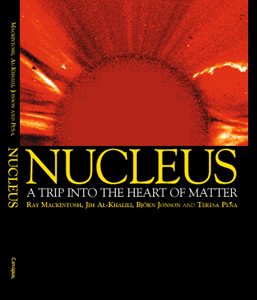by Ray Mackintosh, Jim Al-Khalili, Björn Jonson and Teresa Peña, Canopus Publishing, ISBN 0953786838, £14.95.
A lot of care and attention have gone into this attractive book. The authors are all eminent nuclear physicists who have developed an interest in outreach and public awareness of science, and it shows. Around their text, the book has been tastefully designed and illustrated, depicting the quest to unravel the ultramicroscopic structure of matter, particularly during the 20th century.

The keynote is the book’s nuclear physics standpoint. Fundamental particles and their constituent quarks and gluons are only mentioned in passing, but this is no obstacle.
Physics is a collection of natural phenomena, but it needs physicists to interpret it and to make it understandable, and the book continually underlines the role played by pioneers like Rutherford, Hofstadter and Mottelson. After introducing the nuclear structure of our everyday world, it goes on to point out a wider nuclear landscape – the wealth of synthetic unstable isotopes and their production, behaviour and properties.
As well as its ominous implications for warfare and its still-considerable contribution to power supply, nuclear physics has a range of applications in medicine, industry, the environment and even the home, essentially through the manufacture of radioisotopes, which again are well documented and illustrated in this book.
Nuclear physics provides a prolific source of power on many different scales. At the beginning of the 20th century, physicists did not even understand what made the Sun shine. The subsequent understanding of the role of nuclear mechanisms in astrophysics evolved slowly through the work of major figures, like Hans Bethe and William Fowler. At this point of history the book strangely deviates from its policy of presenting cameo portraits of key researchers.
Modern cosmologists try to work out what happened in the first tiny fraction of a second after the Big Bang. The universe had reached the ripe old age of one second before any nuclei appeared on the scene. Having carefully traced the role of nuclei back to this entry point, the book ironically ends.
There are a few minor errors – Rutherford is introduced twice and a bubble chamber photograph of the discovery of the positron is upside down. Perhaps the advertised selling price is another error. How can such an attractive book be made available so cheaply? Nucleus is one of the first books to be produced by Canopus, a new force in popular science publishing. Buy it while stocks last.





